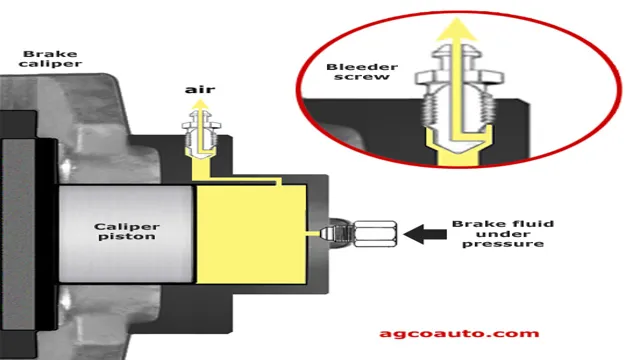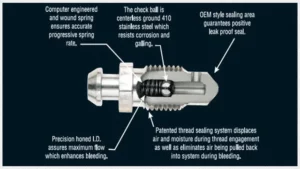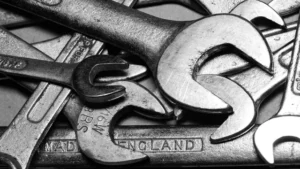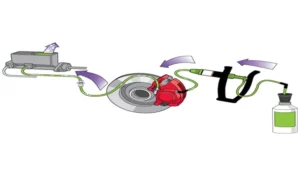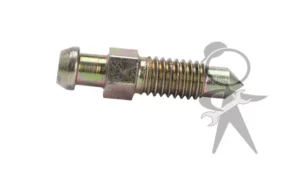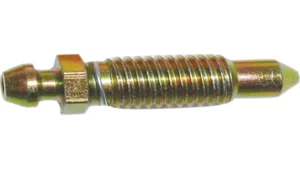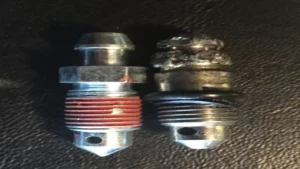Are you familiar with the brakes of your car? If yes, then you might know about brake bleeding, which is a crucial maintenance procedure to ensure the optimum performance of your vehicle’s braking system. Brake bleeding is a process of removing trapped air bubbles from the braking system that can affect its efficiency and response time. One of the critical components of brake bleeding is the brake bleeder screw, which plays a significant role in the process.
Do you know how a brake bleeder screw works? If not, keep reading to find out.
Understanding the Brake Bleeder Screw
Have you ever wondered how your car’s brake bleeder screw works? Well, the brake bleeder screw is a small component that plays a crucial role in the car’s brake system. It is located at the top of the brake caliper and helps to release air bubbles that can form within the brake lines. The screw allows brake fluid to flow out of the brake caliper, which helps to eliminate any air that may have entered the brake system.
This prevents brake fade and ensures that your brakes work effectively when you press the brake pedal. Therefore, it is important to ensure that the brake bleeder screw is functioning correctly and is free of any blockages. If you encounter any brake issues, it’s always best to have a professional mechanic inspect your vehicle.
Appearance and Purpose of a Brake Bleeder Screw
The brake bleeder screw is a small but important part of a vehicle’s braking system. It is typically a small screw located at the top of the brake caliper or cylinder, and its purpose is to allow air to escape from the system. When the brakes are applied, the pressure on the brake fluid increases, causing the brake pads or shoes to engage.
However, if there is air in the system, this can cause the brakes to feel spongy or unresponsive. This is where the brake bleeder screw comes in. By opening the screw, the air is allowed to escape, allowing the brake system to work properly.
The appearance of the brake bleeder screw may vary depending on the make and model of the vehicle, but it is typically a small, hexagonal-shaped screw. It is important to ensure that the screw is properly tightened after bleeding, as any looseness can cause leaks in the brake system. Ultimately, understanding the function of the brake bleeder screw can help keep your brakes safe and reliable while driving.
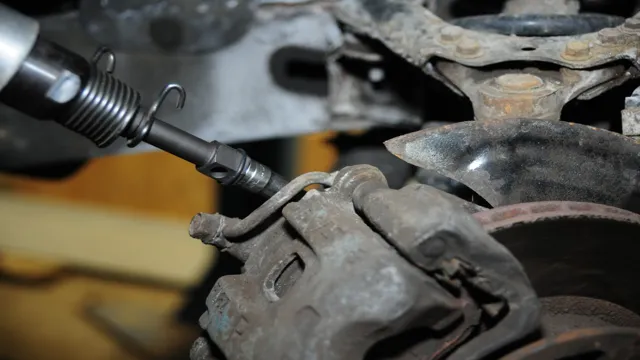
Function of a Brake Bleeder Screw
A brake bleeder screw is a vital component of a vehicle’s braking system that controls the release of air bubbles and other impurities that can cause decreased performance or even complete brake failure. By opening the screw, mechanics can flush out air and contaminants, allowing fresh brake fluid to flow into the caliper. This ensures that the brakes operate at maximum efficiency, providing optimal stopping power and preventing dangerous situations.
The screw is designed to be easily adjustable, allowing for precision control over the pressure of the fluid being released. Understanding the importance of the brake bleeder screw and ensuring it is functioning correctly is essential for maintaining a vehicle’s safety and reliability. So, it’s always recommended to have a professional mechanic check and maintain the brakes regularly to avoid any mishaps on the road.
How to Use a Brake Bleeder Screw
If you ever need to replace or repair your brake system, you may find yourself needing to use a brake bleeder screw. But how does a brake bleeder screw work? It’s actually quite simple. A brake bleeder screw is a small valve located on each of your vehicle’s brake calipers or wheel cylinders.
It functions by allowing brake fluid and air to be released from the system, purging them from the lines. This helps eliminate any air bubbles that could cause the brakes to become spongy and unresponsive. To use a brake bleeder screw, you typically need to attach a special tool called a bleeder wrench to the screw.
Then, you’ll loosen the screw to allow the fluid to flow out, watching for any air bubbles that may appear. Lastly, you’ll tighten the screw back up, repeating the process until all of the air is purged and the fluid is flowing out smoothly. By understanding how a brake bleeder screw works, you can help ensure that your brakes are working as they should be.
Tools Required for Bleeding Brakes
Brake Bleeder Screw Bleeding your car’s brakes may seem like a daunting task, but it is essential for maintaining safety while driving. To properly bleed brakes, you will need a few essential tools. First, you will need a brake bleeder screw, which is a small valve located on the brake caliper.
Additionally, you will need a brake fluid reservoir, brake caliper wrench, and a clear rubber hose that will fit snugly over the bleeder screw. Once all the tools are in place, you can begin the process of bleeding your brakes. To start, fill your brake fluid reservoir with fresh brake fluid.
Next, locate the brake bleeder screw on your caliper and use the caliper wrench to loosen it. Make sure to attach the clear rubber hose over the bleeder screw before opening it. With the hose securely attached, have a friend or use a brake bleeder pump to slowly pump the brake pedal.
By doing this, the brake fluid should steadily exit the bleeder screw and into the clear hose, allowing any air bubbles to escape and ensuring the brake system pressure remains constant. Once all the air bubbles have been purged from the system, make sure to tighten the bleeder screw and remove the clear rubber hose. Finally, check and refill your brake fluid reservoir to the recommended level.
Remember to repeat this process for each brake caliper. In conclusion, bleeding brakes is an integral part of car maintenance and helps to ensure safety on the road. By using the correct tools, like a brake bleeder screw and clear rubber hose, you can easily and quickly eliminate any air bubbles from your brake system.
Don’t forget to check and refill your brake fluid reservoir, and repeat this process for each brake caliper. Safe travels!
Steps to Bleed Brakes Using a Bleeder Screw
Bleeding brakes is an important maintenance task for any car owner to keep their vehicle running smoothly and safely. One way to accomplish this is by using a brake bleeder screw. Here are some steps to follow:
Locate the brake bleeder screw on your vehicle. It is usually found near the caliper on each wheel.
Attach a clear plastic tube to the bleeder screw and place the other end in a container to catch the old brake fluid. Have someone press the brake pedal while you loosen the bleeder screw.
Keep an eye on the fluid level in the master cylinder and refill it as needed. Close the bleeder screw before releasing the brake pedal.
Repeat this process on each wheel until all four have been bled. By following these steps, you can ensure that your brakes are working properly and prevent potential accidents due to brake failure. Don’t forget to dispose of the old brake fluid properly and refill with new fluid according to your manufacturer’s specifications.
Common Mistakes to Avoid When Bleeding Brakes
Bleeding brakes can be a complicated task for those who have never done it before. One of the common mistakes people make is not using a brake bleeder screw. This is an essential tool that helps to get rid of the air bubbles that get trapped inside the brake lines, which affects brake performance.
To use the brake bleeder screw, first, loosen the screw, then press the brake pedal, and then tighten the screw back up. This process forces the brake fluid and air bubbles out of the brake lines, which ensures efficiency and safety. Using a brake bleeder screw may seem daunting, but with some practice and patience, anyone can do it.
Remember, safety always comes first, so be sure to have the proper tools and follow the manufacturer’s instructions carefully.
Maintenance and Replacement of Brake Bleeder Screws
Brake bleeder screws are small but essential parts of a vehicle’s braking system. They work by allowing air and fluid to escape when bleeding the brakes, which prevents air bubbles and contaminants from entering the brake lines. However, over time, these screws can become corroded or stripped, making them difficult to remove and causing problems with brake performance.
It’s important to regularly check and maintain your brake bleeder screws to prevent any potential issues. If a screw is damaged, replacement is necessary to ensure the safe operation of your vehicle. When replacing a brake bleeder screw, it’s important to use the correct size and thread pitch to ensure a proper fit and prevent any leaks.
By keeping these small but crucial parts in good condition, you can help ensure the safety and reliability of your vehicle’s braking system.
Signs of a Faulty Bleeder Screw
Brake Bleeder Screws Have you noticed a decrease in your braking performance or seen fluid leaking from your brakes? These may be signs of a faulty or damaged brake bleeder screw. The bleeder screw plays a crucial role in the brake system by allowing air to escape and maintaining proper pressure. Over time, the screw can become rusted, stripped, or otherwise damaged, preventing it from functioning properly.
Regular maintenance and checks can prevent issues from occurring. If a bleeder screw is found to be damaged or faulty, it should be replaced promptly to ensure proper brake function and safety. Trusting the health of your brakes to a professional mechanic is recommended, as they can ensure proper replacement and care.
By staying on top of regular maintenance and addressing issues promptly, you can maintain the safety and efficiency of your brakes.
When to Replace a Brake Bleeder Screw
Brake Bleeder Screw Maintaining your braking system is essential for safety and performance on the road. Your brake bleeder screw plays a critical role in this system, ensuring proper fluid flow and pressure. Over time, the screw may become worn, corroded, or damaged, leading to leaks or loss of pressure.
To prevent critical failure of your braking system, it’s important to replace a brake bleeder screw at the first sign of damage or wear. This may include rust or erosion on the threads or the head of the screw, or if you have trouble loosening or tightening it during routine maintenance. A simple replacement of the brake bleeder screw can save you from serious accidents or costly repairs down the road.
Regular checks and replacements can keep your braking system in top shape and your vehicle safe on the road.
Conclusion
In summary, a brake bleeder screw works by releasing air bubbles trapped in the brake lines, ensuring maximum stopping power and preventing disastrous accidents. It’s like popping a pesky bubble wrap that’s been in your way, only this time, it’s crucial for your safety and the well-being of your vehicle. So, don’t let those air bubbles get in the way of your smooth braking experience and always make sure your brake bleeder screw is doing its job correctly.
“
FAQs
What is a brake bleeder screw and why is it important in brake maintenance?
A brake bleeder screw is a small valve located on a brake caliper or wheel cylinder that allows air bubbles to escape during brake bleeding. It is important in brake maintenance because air in the brake lines can cause decreased braking performance and safety issues.
How does a brake bleeder screw work?
When the brake pedal is pressed, brake fluid is forced through the brake lines and into the brake calipers or wheel cylinders. The brake bleeder screw allows air bubbles to escape as the brake fluid is forced through the system, ensuring that only brake fluid remains in the lines.
How often should brake bleeder screws be checked and replaced?
Brake bleeder screws should be checked and replaced if necessary during regular brake maintenance, typically every 30,000 to 60,000 miles. However, if you notice decreased braking performance or a spongy brake pedal, it may be necessary to check the brake bleeder screws sooner.
Can a faulty brake bleeder screw cause brake failure?
Yes, a faulty brake bleeder screw can cause brake failure by allowing air to remain in the brake lines. This can result in decreased braking performance, longer stopping distances, and potentially dangerous situations.
How can I identify a faulty brake bleeder screw?
Signs of a faulty brake bleeder screw include a spongy brake pedal, decreased braking performance, and a hissing sound when the brake pedal is pressed. If you suspect a faulty brake bleeder screw, it should be checked and replaced if necessary during regular brake maintenance.
Is it safe to replace a brake bleeder screw on my own?
If you have experience with car maintenance and the proper tools, it is possible to replace a brake bleeder screw on your own. However, if you are unsure or uncomfortable with the process, it is recommended to have a professional mechanic perform the replacement to ensure proper brake function and safety.
Can I drive my car with a faulty brake bleeder screw?
It is not recommended to drive your car with a faulty brake bleeder screw as it can lead to decreased braking performance and safety issues. If you suspect a faulty brake bleeder screw, it should be checked and replaced if necessary before driving the vehicle.
